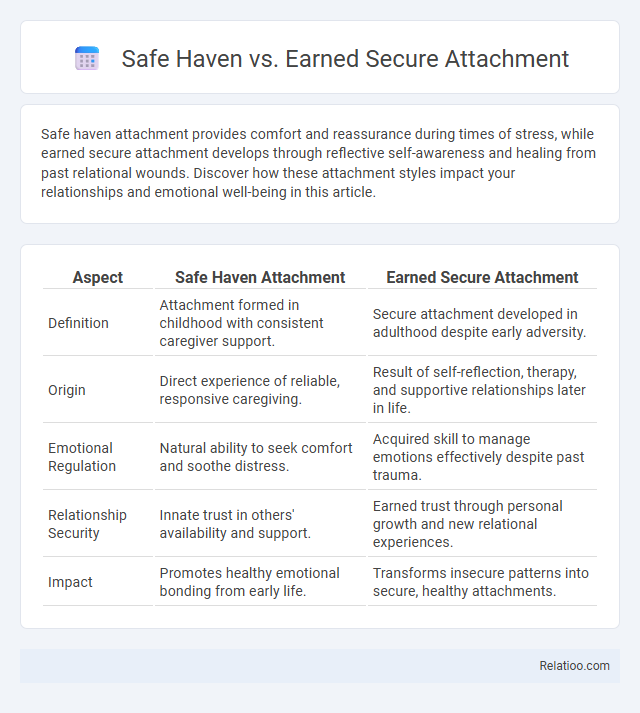Safe haven attachment provides comfort and reassurance during times of stress, while earned secure attachment develops through reflective self-awareness and healing from past relational wounds. Discover how these attachment styles impact your relationships and emotional well-being in this article.
Table of Comparison
| Aspect | Safe Haven Attachment | Earned Secure Attachment |
|---|---|---|
| Definition | Attachment formed in childhood with consistent caregiver support. | Secure attachment developed in adulthood despite early adversity. |
| Origin | Direct experience of reliable, responsive caregiving. | Result of self-reflection, therapy, and supportive relationships later in life. |
| Emotional Regulation | Natural ability to seek comfort and soothe distress. | Acquired skill to manage emotions effectively despite past trauma. |
| Relationship Security | Innate trust in others' availability and support. | Earned trust through personal growth and new relational experiences. |
| Impact | Promotes healthy emotional bonding from early life. | Transforms insecure patterns into secure, healthy attachments. |
Understanding Attachment: Safe Haven vs Earned Secure
Understanding attachment involves distinguishing between a safe haven, which provides comfort and reassurance during distress, and earned secure attachment, where individuals develop secure relational patterns despite early insecurity through reflection and growth. Your ability to seek a safe haven indicates emotional reliance, while earned secure attachment reflects resilience and conscious efforts to form healthy bonds. Recognizing these differences helps you cultivate stronger emotional connections and personal well-being.
What Is a Safe Haven Attachment?
Safe haven attachment refers to a dynamic where an individual seeks comfort and protection from a trusted caregiver during times of distress, facilitating emotional regulation and security. This type of attachment is critical for fostering a secure base, distinguishing it from earned secure attachment, which results from overcoming early attachment traumas through therapy and self-awareness. Understanding safe haven attachment helps clarify how secure attachments form naturally, providing a foundation for healthy emotional development and interpersonal relationships.
Defining Earned Secure Attachment
Earned secure attachment describes individuals who develop secure attachment patterns in adulthood despite experiencing insecure or disorganized attachments in childhood. This adaptive capacity often results from positive therapeutic relationships or corrective emotional experiences that reshape internal working models of self and others. Unlike safe haven, which refers to the immediate comfort provided by attachment figures during distress, earned secure attachment reflects an internalized, stable sense of security cultivated over time.
How Safe Haven and Earned Secure Attachment Develop
Safe haven develops through consistent, responsive caregiving in early childhood, where a caregiver provides comfort and protection during times of distress, fostering a secure base for emotional regulation. Earned secure attachment emerges later, often in adulthood, when individuals with insecure or disorganized early attachments engage in therapeutic work or form trusting relationships that help them reframe past experiences and develop reliable emotional connections. Both safe haven and earned secure attachment rely on experiences of safety, trust, and emotional attunement but differ in timing and the potential for change through intentional interpersonal processes.
Key Differences Between Safe Haven and Earned Secure Attachment
Safe haven attachment refers to the comfort and security provided by a trusted caregiver during times of distress, while earned secure attachment describes adults who have developed secure attachments despite adverse childhood experiences. The key difference lies in safe haven being an immediate emotional refuge, whereas earned secure attachment reflects a long-term, internalized sense of security achieved through personal growth and therapeutic work. Safe haven is a situational response, whereas earned secure attachment represents a stable, resilient attachment style formed over time.
Signs of Safe Haven Attachment in Relationships
Signs of safe haven attachment in relationships include seeking comfort and reassurance from a partner during times of stress or fear, which fosters emotional security and trust. Individuals with safe haven attachment often turn to their partner as a source of protection and soothing, reflecting a secure emotional bond. This attachment style contrasts with earned secure attachment, where trust and security develop over time despite insecure beginnings.
Characteristics of Earned Secure Attachment
Earned secure attachment is characterized by individuals who, despite early adverse experiences, have developed a healthy, trusting bond through self-reflection and therapeutic work. You demonstrate emotional resilience, balanced intimacy, and the ability to form safe haven connections where you both seek and provide comfort. This attachment style contrasts with safe haven attachment, which primarily emphasizes immediate emotional refuge without necessarily overcoming earlier attachment challenges.
The Role of Childhood Experiences in Attachment Styles
Childhood experiences fundamentally shape attachment styles by influencing whether a person develops a safe haven, earned secure attachment, or other forms of attachment. A safe haven emerges from consistent and responsive caregiving that fosters trust and emotional security in early years. Your ability to achieve an earned secure attachment reflects conscious efforts to heal and reframe past relational patterns, transforming early adversities into healthier emotional connections.
Healing Through Earned Secure Attachment
Healing through earned secure attachment involves transforming insecure attachment patterns by developing a consistent and reliable safe haven within oneself, distinct from the original caregiver-based safe haven. Unlike the innate safe haven provided by caregivers during childhood, earned secure attachment emerges from therapeutic relationships and self-reflective practices that foster emotional regulation and trust. This process enables individuals to heal relational wounds and build resilience, promoting healthier interpersonal bonds and psychological well-being.
Fostering Healthy Attachment: Practical Steps
Fostering healthy attachment requires understanding distinctions between Safe Haven, Earned Secure Attachment, and Safe Base concepts. Providing consistent emotional support as a Safe Haven helps children regulate stress and feel protected, while nurturing a Safe Base encourages exploration with confidence. Cultivating Earned Secure Attachment involves reflective practices and therapeutic interventions to repair early attachment wounds and promote resilience in adult relationships.

Infographic: Safe haven vs Earned secure attachment
 relatioo.com
relatioo.com